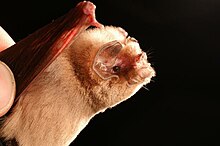
The Mexican free-tailed bat or Brazilian free-tailed bat is a medium-sized bat native to the Americas, so named because its tail can be almost half its total length and is not attached to its uropatagium. It has been claimed to have the fastest horizontal speed of any animal, reaching top ground speeds over 99 mph (160 km/h). It also flies the highest among bats, at altitudes around 3,300 m (10,800 ft).

The family Mormoopidae contains bats known generally as mustached bats, ghost-faced bats, and naked-backed bats. They are found in the Americas from the Southwestern United States to Southeastern Brazil.

The soprano pipistrelle is a small species of bat. It is found in Europe and often roosts on buildings.

The big naked-backed bat, is a bat species from South and Central America.
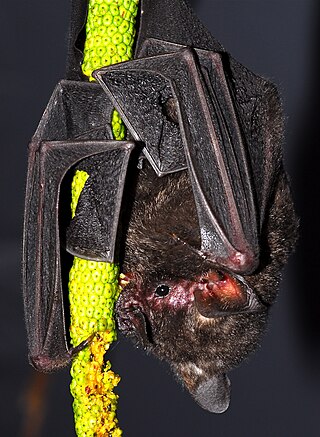
Seba's short-tailed bat is a common and widespread bat species in the family Phyllostomidae. They are found in Central America, the northern parts of South America, and in the Antilles islands.

The tent-making bat is an American leaf-nosed bat (Phyllostomidae) found in lowland forests of Central and South America. This medium-sized bat has a gray coat with a pale white stripe running down the middle of the back. Its face is characterized by a fleshy noseleaf and four white stripes. Primarily a frugivore, it may supplement its diet with insects, flower parts, pollen, and nectar. Its common name comes from its curious behavior of constructing tents out of large, fan-shaped leaves. These roosts provide excellent protection from the tropical rains, and a single tent roost may house several bats at once. This bat is quite common in its geographic range; hence, its conservation status is listed as Least Concern.
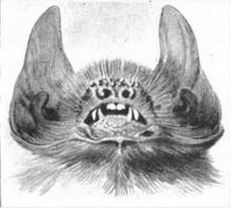
Davy's (lesser) naked-backed bat is a small, insect-eating, cave-dwelling bat of the Family Mormoopidae. It is found throughout South and Central America, including Trinidad, but not Tobago, Guyana, Suriname, or French Guiana. Specimens of this bat had been found infected with rabies in Trinidad during the height of that island's vampire-bat-transmitted rabies epidemic of the early half of the 20th century, but not in recent times.

The large slit-faced bat is a species of slit-faced bat with a broad distribution in forest and savanna habitats in West, Central, and East Africa. N. marica, is the available name for the southern savanna species if it is recognized as distinct from this species.

The greater mouse-eared bat is a European species of bat in the family Vespertilionidae.

The inland broad-nosed bat is a species of vesper bat. They are endemic to Australia and widespread throughout the inland, especially in arid and semi-arid regions. This insectivorous microbat, measuring 12 centimetres (4.7 in) in length, roosts in tree hollows during the day and forages over woodland and water at night.

The little broad-nosed bat translates to "Grey’s darkness creeper". Sometimes called Grey’s broad-nosed after the third governor of South Australia, Sir John Edward Grey. It is a species of vesper bat, which is one of the largest and best-known family of bats. They are endemic to Australia, are insectivores and have a broad range within the mainland, mainly in hot arid areas but also found in tropical rainforests.

Nyctophilus geoffroyi is a vespertilionid bat. a flying nocturnal mammal found in Australia, The species is relatively common. They have been referred to as the lesser long-eared bat.
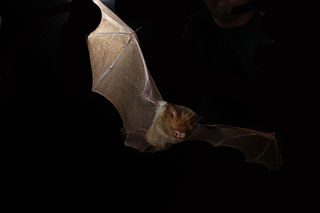
The diadem leaf-nosed bat or diadem roundleaf bat is one of the most widespread species of bat in the family Hipposideridae. It is probably most closely related to Hipposideros demissus from Makira and to Hipposideros inornatus from the Northern Territory in Australia. Hipposideros diadema is found in Australia, Indonesia, Malaysia, Myanmar, the Philippines, Thailand, and Vietnam.
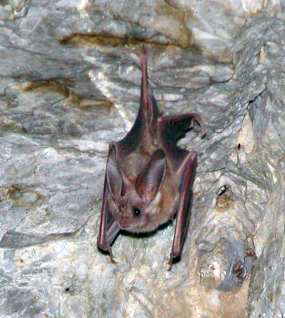
The California leaf-nosed bat is a species of bat in the family Phyllostomidae. It is found in Mexico and the United States. Its natural habitat is hot deserts.

Macrotus is a genus of bats in the Neotropical family Phyllostomidae. This genus contains two species, Macrotus californicus commonly known as California leaf-nosed bat and Macrotus waterhousii commonly known as Mexican or Waterhouse's leaf-nosed bat. The range of this family includes the warmer parts of the southwestern United States, Mexico, Central and South America, and the Bahama Islands. Characteristic for the genus are large ears and the name giving triangular skin flap above the nose, the "leaf". The California Leaf-nosed Bat inhabits the arid deserts of the southwestern United States as far north as Nevada, south to Baja California and Sonora, Mexico. The California Leaf-nosed Bat is of medium size, with a total length between 9 and 11 cm Its most distinctive features are the large ears, connected across the forehead. The body is pale grayish brown dorsally with whitish under parts. The pelage (fur) on the body is silky, the hairs on the back about 8 mm, on the front about 6 mm long. The posterior base of the ears are covered with hair of a woolly texture while the interior surface and most of the anterior border shows scattered long hairs.

The Antillean ghost-faced bat is a species of bat in the family Mormoopidae. It is found in the Greater Antilles: Cuba, Hispaniola Jamaica, and Puerto Rico.

The lesser mouse-tailed bat is a species of microbat in the family Rhinopomatidae. Also referred to as Hardwicke's lesser mouse-tailed bat and long-tailed bat, it is named after Major General Thomas Hardwicke (1755–1835), an English soldier and naturalist who served many years in India. It is found in North Africa, some parts of central and eastern Africa, West Asia and east to the Indian subcontinent.
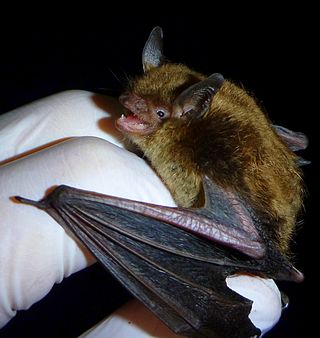
The little brown bat or little brown myotis is an endangered species of mouse-eared microbat found in North America. It has a small body size and glossy brown fur. It is similar in appearance to several other mouse-eared bats, including the Indiana bat, northern long-eared bat, and Arizona myotis, to which it is closely related. Despite its name, the little brown bat is not closely related to the big brown bat, which belongs to a different genus.

The Virginia big-eared bat is one of two endangered subspecies of the Townsend's big-eared bat. It is found in Virginia, West Virginia, North Carolina, and Kentucky. In 1979, the US Fish and Wildlife Service categorized this as an endangered species. There are about 20,000 left and most of them can be found in West Virginia. The Virginia big-eared bat is the state bat of Virginia.
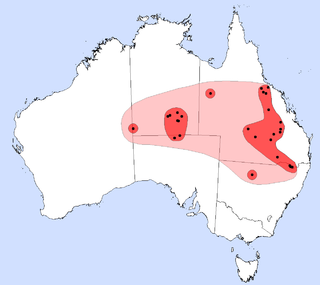
Setirostris eleryi is a species of small insectivorous bat found in inland eastern Australia. It is the sole species of the molossid genus Setirostris, a name that refers to the coarse bristles on their faces. Earlier common names have referred to this unique feature, and the 'free-tail' that is a common feature of its microchiropteran family, the Molossidae; no single common name emerged during the taxonomic revisions that identified what was referred to as the bristle-faced freetail.
